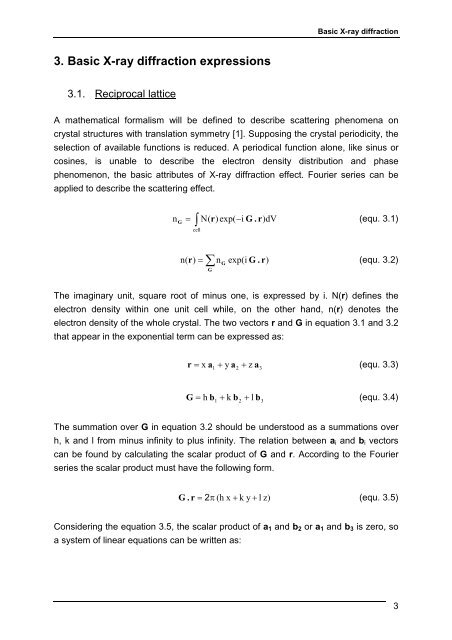Diploma Thesis - Erich Schmid Institute
Diploma Thesis - Erich Schmid Institute
Diploma Thesis - Erich Schmid Institute
Create successful ePaper yourself
Turn your PDF publications into a flip-book with our unique Google optimized e-Paper software.
3. Basic X-ray diffraction expressions<br />
3.1. Reciprocal lattice<br />
Basic X-ray diffraction<br />
A mathematical formalism will be defined to describe scattering phenomena on<br />
crystal structures with translation symmetry [1]. Supposing the crystal periodicity, the<br />
selection of available functions is reduced. A periodical function alone, like sinus or<br />
cosines, is unable to describe the electron density distribution and phase<br />
phenomenon, the basic attributes of X-ray diffraction effect. Fourier series can be<br />
applied to describe the scattering effect.<br />
n<br />
G<br />
= ∫ N(<br />
r)<br />
exp( −i<br />
G . r)<br />
dV<br />
(equ. 3.1)<br />
cell<br />
∑<br />
n ( r ) = nG<br />
exp( i G . r)<br />
(equ. 3.2)<br />
G<br />
The imaginary unit, square root of minus one, is expressed by i. N(r) defines the<br />
electron density within one unit cell while, on the other hand, n(r) denotes the<br />
electron density of the whole crystal. The two vectors r and G in equation 3.1 and 3.2<br />
that appear in the exponential term can be expressed as:<br />
r = x a + y a + z a<br />
(equ. 3.3)<br />
1<br />
1<br />
2<br />
2<br />
3<br />
G = h b + k b + l b<br />
(equ. 3.4)<br />
The summation over G in equation 3.2 should be understood as a summations over<br />
h, k and l from minus infinity to plus infinity. The relation between ai and bi vectors<br />
can be found by calculating the scalar product of G and r. According to the Fourier<br />
series the scalar product must have the following form.<br />
3<br />
G . r = 2π<br />
(h x + k y + l z)<br />
(equ. 3.5)<br />
Considering the equation 3.5, the scalar product of a1 and b2 or a1 and b3 is zero, so<br />
a system of linear equations can be written as:<br />
3

















